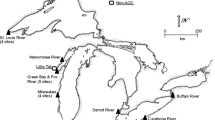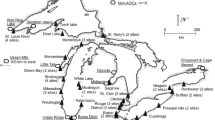Abstract
Point Pelee National Park in southwestern Ontario, Canada—a major migratory route and vital breeding area for many birds—has localized areas of organochlorine (OC) contamination from the 1950s and 1960s. During 2002, we investigated the effect of tissue OC contaminant levels on the physiology and growth of nestling tree swallows (Tachycineta bicolor). Polychlorinated biphenyl (PCB) contamination in the nestlings positively correlated with hepatic ethoxy-, benzyloxy-, and pentoxyresorufin-o-dealkylase enzyme activities and liver size. Despite detectable physiologic changes associated with body burdens of PCBs, reproductive success of breeding pairs was not affected. Hatching date was negatively correlated with PCB levels, alkoxyresorufin-O-dealkylase (alkROD) activities, liver size, and serum protein levels. alkROD activities were largely dependent on hatching date because insect prey contaminated with PCBs were only abundant during a limited period of time during the breeding season.


Similar content being viewed by others
References
Arenal CA, Halbrook RS, Woodruff M (2004) European starling (Sturnus vulgaris): Avian model and monitor of polychlorinated biphenyl contamination at a Superfund site in southern Illinois, USA. Environ Toxicol Chem 23:93–104
Bishop C, Mahony N, Trudeau S, Pettit K (1999) Reproductive success and biochemical effects in tree swallows (Tachycineta bicolor) exposed to chlorinated hydrocarbon contaminants in wetlands of the Great Lakes and St. Lawrence River basin, USA and Canada. Envion Toxicol Chem 18:263–271
Bishop CA, Boermans HJ, Ng P, Campbell GD, Struger J (1998) Health of tree swallows (Tachycineta bicolor) nesting in pesticide-sprayed apple orchards in Ontario, Canada: Immunological parameters. J Toxicol Environ Health 55:531–559
Bishop CA, Koster MD, Chek AA, Hussell DJT, Jock K (1995) Chlorinated hydrocarbons and mercury in sediments, red- winged blackbirds (Agelaius phoeniceus) and tree swallows (Tachycineta bicolor) from wetlands in the Great Lakes -St. Lawrence river basin. Environ Toxicol Chem 14:491–501
Custer CM, Custer TW, Dummer PM, Munney KL (2003) Exposure and effects of chemical contaminants on tree swallows nesting along the Housatonic river, Berkshire County, Massachusetts, USA, 1998-2000. Environ Toxicol Chem 22:1605–1621
Custer T, Custer CM, Hines RK, Stromborg KL, Allen PD, Melancon MJ, Henshel DS (2001a) Organochlorine contaminants and biomarker response in double-crested cormorants nesting in Green Bay and Lake Michigan, Wisconsin, USA. Arch Environ Contam Toxicol 40:89–100
Custer T, Custer CM, Dickerson K, Allen K, Melancon MJ, Schmitt LJ (2001b) Polycyclic aromatic hydrocarbons, aliphatic hydrocarbons, trace elements, and monooxygenase activity in birds nesting on the North Platte River, Casper, Wyoming, USA. Environ Toxicol Chem 20:624–631
Custer C, Custer T, Allen P, Stromborg K, Melancon M (1998) Reproduction and Environmental contamination in tree swallows nesting in the Fox River Drainage and Green Bay, Wisconsin, USA. Environ Toxicol Chem 17:1786–1798
Drouillard K, Fernie KJ, Smits JE, Bortolotti GR, Bird DM, Norstrom RJ (2001) Bioaccumulation and toxicokinetics of 42 polychlorinated biphenyl congeners in American kestrels (Falco sparverius). Environ Toxicol Chem 20:2514–2522
Gilbertson M, Kubiak T, Ludwig J (1991) Great Lakes embryo mortality, edema and deformities syndrome (GLEMEDS) in colonial fish-eating birds: Similarity to chick-edema disease. J Toxicol Environ Health 33:455–520
Hoffman DJ, Rice CP, Kubiak TJ (1996) PCBs and dioxins in birds. In: Beyer WN, Heinz GH, Redmon-Norwood AW (eds) Environmental contaminants in wildlife: Interpreting tissue concentrations. Lewis, New York, NY, pp 165–207
Kennedy SW, Jones SP (1994) Simultaneous measurment of cytochrome P4501A catalytic activity and total protein concentration with a fluorescence plate reader. Anal Biochem 222:223
Kuzyk ZA, Burgess NM, Stow JP, Fox GA (2003) Biological effects of marine PCB contamination on Black Guillemot nestlings at Saglek, Labrador: Liver biomarkers. Ecotoxicology 12:183–197
McCarty JP (2001) Use of tree swallows in studies of environmental stress. Rev Toxicol 4:61–104
Melancon MJ (1996) Development of cytochrome P450 in avian species as a biomarker for environmental contaminant exposure and effect: procedures and baseline values. In: Bengston DA, Henshel DS (eds) Environmental toxicology and risk assessment: Biomarkers and risk assessment ASTM STP 1306, 5th Vol. American Society for Testing and Materials, West Conschohocken. PA
Nichols JW, Larsen CP, McDonald ME, Niemi GJ, Ankley G (1995) Bioenergetics-based model for accumulation of PCBs by nestling tree swallows, Tachycineta bicolor. Environ Sci Technol 29:604–612
O’Connor Associates Environmental Inc. 2001. Environmental Monitoring Point Pelee National Park, Leamington, Ontario. KIN-0-00509, 1-40. Oakville, ON (report)
Petrulis JR, Bunce NJ (1999) Competitive inhibition by inducer as a confounding factor in the use of the ethoxyresorufin-O-deethylase (EROD) assay to estimate exposure to dioxin-like compounds. Toxicol Lett 105:251–260
Rattner BA, Melancon MJ, Custer TW, Hothems RL (1966) Cytochrome P450 and contaminant concentrations in nestling black-crowned night-herons and their interrelationship with sibling embryos. Envion Toxicol Chem 15:715–721
Russell RW, Hecnar SJ, Haffner GD (1995) Organochlorine pesticide residues in southern Ontario spring peepers. Envion Toxicol Chem 14:815–817
Smits JE, Wayland ME, Miller MJ, Liber K, Trudeau S (2000) Reproductive, immune, and physiological end points in tree swallows on reclaimed oil sands mine sites. Environ Toxicol Chem 19:2951–2960
Smits JEG, Bortolotti GR, Sebastian M, Ciborowski JJH (2005, in press) Spatial, temporal, and dietary determinants of organic contaminants in nestling tree swallows in Point Pelee National Park, Ontario, Canada. Environ Toxicol Chem
Walker CH (1998) Avian forms of cytochrome P450. Comp Biochem Physiol C 121:65–72
Wardrop SL, Ydenberg (2003) Date and parental quality effects in the seasonal decline in reproductive performance of the tree swallow Tachycineta bicolor: Interpreting results in light of potential experimental bias. Ibis 145:439–447
Wayland M, Trudeau S, Marchant T, Parker D, Hobson KA (1998) The effect of pulp and paper mill effluent on an insectivorous bird, the tree swallow. Ecotoxicology 7:237–251
Yorks AL (1999) Effects of polychlorinated biphenyls (PCBs) on reproduction, physiological processes, and biomarkers in tree swallows (Tachycineta bicolor). Doctoral dissertation, University of Maryland, Baltimore, MD
Acknowledgments
We thank Suzanne Trudeau from Environment Canada for providing the basic EROD assay protocol and Alison Anaka and Patrick Garcia for research assistance. We would like to thank numerous people from Point Pelee National Park (Parks Canada) for their continuous support: G. Mouland, D. Reive, T. Linke, and the park wardens. We thank Ken Drouillard for GC analyses and preparations. This research was funded through grants from NSERC (J. S. and G. B.), Suncor Energy, and Syncrude Canada Ltd (J. S. and G. B.).
Author information
Authors and Affiliations
Corresponding author
Rights and permissions
About this article
Cite this article
Papp, Z., Bortolotti, G.R. & Smits, J.E.G. Organochlorine Contamination and Physiological Responses in Nestling Tree Swallows in Point Pelee National Park, Canada. Arch Environ Contam Toxicol 49, 563–568 (2005). https://doi.org/10.1007/s00244-004-0214-x
Received:
Accepted:
Published:
Issue Date:
DOI: https://doi.org/10.1007/s00244-004-0214-x




